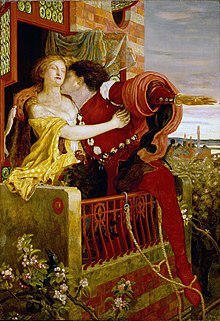The purpose of
marriage was not only raising and protecting children, but a way to form family
alliances and for families to make sure that somebody worthy was the heir.
The fact that love and marriage need to be connected was
never unanimous and in most societies love marriages were considered a foolish
choice and frowned upon. Usually, families would have denied their children a
marriage that wasn’t convenient for both parties. Before the 18th
century, most societies thought that love came after people got married. The
medieval societies were accustomed with the idea of love from poems and the
troubadours’ songs, but most people considered this an aristocratic way to
excuse adultery.
From Tradition to Romance
 |
| Romeo and Juliet (Ford Madox Brown) |
In most communities where marriages are arranged, the family
makes a transaction with another family Especially in high rank families, this
has been and still is a way to promote economic and politic interests. Parents
have the right to marry their children, especially their girls, with whoever
they want. Arranged marriages imply money transfers that constrained both parts legally to follow certain
conditions, especially related to inheritance.
Although poets like Shakespeare showed that not giving your
children’s permission to marry whom they want could have tragic consequences,
there are few who opposed the marriage arranged by their family. It actually
depended on many factors like personal hope, tradition and social status. Men
looked for women who were able to take care of a home while women hoped for men
who were able to support them. Men usually didn’t get married until they had
financial stability, which usually was around the age of 30 and marrying during
adolescence was uncommon. The same structure is found in other cultures, like
Japan where the average age for marriage rose after the XVI century from 21
years old to 24 years old.
Once philosophies that praised individualism grew in the
last 300 years, marriage for love became a popular concept. Even in
aristocratic families parents stopped imposing their children whom to marry.
Books like Tom Jones, Jane Eyre and Jane’s Austen books showed that marrying
for love was an important thing and women who didn’t marry at all were seen as
a sad case of society, which became another problem.
Being an Old
Unmarried Woman
The fact that marriage started to be done out of love and
young people were more and more stubborn to do so ultimately lead to a lot of
your middle class citizens to remain unmarried and the case of Jane Austen and
her sister Cassandra proves that. Actually the problem of older unmarried women
was one of the things that started the women's rights movement during Victorian times.
The church, although promoted celibacy, was reluctant when
it came to real cases of celibacy because it
was thought that a person would actually have a lot of lust which was
worse. The main purpose of marriage was to procreate but it was also a way to
keep people from sinning. Premarital and extramarital relationships were
completely forbidden and bastards were frowned upon. However, starting with the
XVIII century it started to be a normal behavior among people who dated. If a
pregnancy occurred, they got married. Because people started to get married chaotically,
starting with the XVIII century strict laws regarding marriage appeared.
Marriage and Divorce
 |
| Source |
Due to the fact that marriage out of love became more and
more popular and it was more seen as “match made in Heaven”, divorce was
definitely frowned upon. It was really hard to obtain a divorce and once a person
got divorced, it was rarely followed by another marriage. In England before the
XIX century to get a divorce a person had to obtain an acceptance from the
Parliament, which was extremely costly. The legal divorce procedures were
slowly introduced. During Victorian times, men were allowed to get a divorce if
they thought that their wives had cheated on them but women were unable to do
so, since the rules changed when it came to obtain a divorce as a woman. A
woman needed to show that besides adultery her husband committed other terrible
acts such as cruelty. However, cruelty was also tricky to prove since it was
not considered cruelty if a man beat his wife with a cane that was thinner than
his thumb.
Once the regulations for divorce became clear getting one
became easier. Unfortunately the romantic love ideas were also fueling a lot of
disappointment and a lot of couples were divorcing. Once there was no more
stigma for things like contraception, co-habitation without getting married and
having children outside marriage but also women’s independence, the pressure
for couple to stay together diminished.
It’s safe to say that married women had been at a
disadvantage. Before Victorian times English women were not allowed to own
properties on their names. Men however were allowed to have cheat on their
wives, but the society scolded, stigmatized and isolated women for doing so.
However, in Mediterranean societies a woman was able to take a lover once she
gave her husband an heir.
Interracial Marriages
 |
| Othello and Desdemona (Théodore Chassériau) |
In the Western world there has been banning regarding interracial
marriage in countries like Germany during the Nazi period, South Africa under
apartheid and some states in USA.
Nowadays, there are some laws in certain Arab nations that
revoke the civil rights for women to marry men that are not native to the woman’s
country of birth or men who are non-Muslim. Women who marry outside these rules
risk being subjected to honor killings by male family members.
In Britain there interracial marriages occurred since the 17th
century when more Indian scholars started coming in the country. However these
marriages were not accepted easily by the society but there were also no legal
restrictions. Bu the 19th century this became a normal practice.